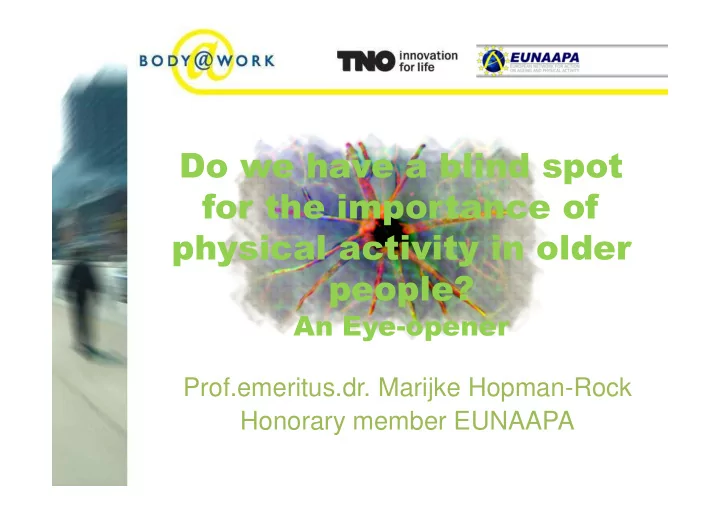

Do we have a blind spot for the importance of physical activity in older people? An Eye-opener Prof.emeritus.dr. Marijke Hopman-Rock Honorary member EUNAAPA
Expecting the future…? Body@Work 2
This is what I hope: Body@Work 3
Importance of physical activity: a blind spot? Unknown to the Unknown Known to public to yourself yourself Known to researchers Open Blind Spot Blind Known to space spot others Unknown Unknown to Hidden area area others Body@Work 4
1987: Vitality and Aging mortality Compression of morbidity Recommendation: prevention by healthy lifestyle! Body@Work 5
Percentage of Dutch people meeting HEPA standards (30 minutes PA a day or sports > 3x pw) according to age group 70 60 50 In Dutch nursing homes PA 40 mean 5,3 minutes a day! (De Ligny et al, 2010) 30 2000- 2002- 2004- 2006- 2008- 2010- 2001 2003 2005 2007 2009 2011 18-34 35-55 56-64 65-74 75+ Source: Hildebrandt et al, 2013, TNO report 6 ECSS 2013
Levels of Evidence for Physical Activity and Exercise on Health Level of Evidence Positive effects on Disease Tertiary prevention A,B,C Health parameters Prevention (primary) A (overhelming Body weight (BMI) CHD CHD from RCT’s and Body fat Diabetes mellitus II Diabetes mellitus II observational Blood pressure Osteoporosis studies) HDL/LDL cholesterol Glucose intolerance Sleep pattern Disability Muscle strength B (strong evidence) Cognitive decline Stroke COPD Bone mass Depression Osteoporosis (osteopenia) Sarcopenia Colon cancer Stroke Self esteem Breast cancer Anxiety, depression Dementia Reumatoïd arthritis Epilepsy Cystic fibrosis C (generally Co-ordination Osteoarthritis positive or Reaction time Kidney disease suggestive Quality of life (? C/D) Low back pain evidence) Independent living Parkinson disease Falls In hospital mortality Body@Work 7
Tak E, Kuiper R, Chorus A, Hopman-Rock M. Prevention of onset and progression of basic ADL disability by physical activity in community dwelling older adults: a meta- analysis. Ageing Res Rev. 2013 Jan;12(1):329-38. Physical activity and Disability: the evidence Risk of incident B-ADL disability • Statistical heterogeneity • No publication bias • Age, FU-period and confounders did not Wu (1999) significantly alter Van den Brink (2005) relationship Stessman (2009) • Quality of study not Ostbye (2002) linearly related to the Leveille (1999) association PA-disability Jenkins (1999) Ishizaki (2000) Haveman-Nies (2003) Avlund (2002) Summary 0 1 2 Pooled OR medium/high vs. low Physical Activity: 0.51 (95% CI: 0.38-0.68; Erwin Tak et al Physical Activity & Disability p<.001)
Biddle et al. position stand ECSS 2012 9 Ecss 2013
Effective strategies • Best Practice Statement ACSM (Cress et al, 2004): Principles of behaviour change (in older persons): Social support FUN!! Self-efficacy Active choices Health contracts Assurance of safety Positive reinforcement Picture Katharine Devereux, Perth Australia • UK National institute for health and clinical Excellence (NICE, Cavell et al, 2006, chapter older adults) http://www.nhs.uk/Livewell/fitness/Pages/physical- activity-guidelines-for-older-adults.aspx 10
Body@Work 11
Why should we promote behavioural change in older persons? Example: condition → Better in is Better out= Peri operative physiotherapy Critical zone time → Event (fall, operation, etc) Topp et al , 2002, Van der Sluis et al , 2007 Slide from dr. Nico van Meeteren 12 APA Sydney 5 October 2009 Nico.vanmeeteren@tno.nl
Dronkers PhD thesis (May 2013): http://dare.ubvu.vu.nl/handle/1871/40383 Young Old Frail 1
What is your blind spot? • Who sports/exercises 2-3 times a week? • Who is going almost always by car? • Who usually bikes to his or her work? • Who walks/bikes with older family members? • Who wants to be physically active more frequently? • Who sits for more than 3 hours a day? Body@Work 14
Special issue on Physical Inactivity (July 2012) 15
16
17
Research community Body@Work 18
EUNAAPA www.eunaapa.org Started in 2005 Free membership Projects from the European Commission 2014: Operating grant Body@Work 19
www.eunaapa.org Body@Work 20
Blind spot in our culture?? An Eye-opener Body@Work 21
To increase physical activity in older people! Body@Work 22
Thanks for your attention! Prof.em.dr. Marijke Hopman-Rock marijke.hopman@tno.nl VU university Amsterdam: m.hopman@vumc.nl Twitter @marijkehopman www.EUNAAPA.org Twitter: @eunaapa www.bodyatwork.nl 23
Body@Work 24
Recommend
More recommend